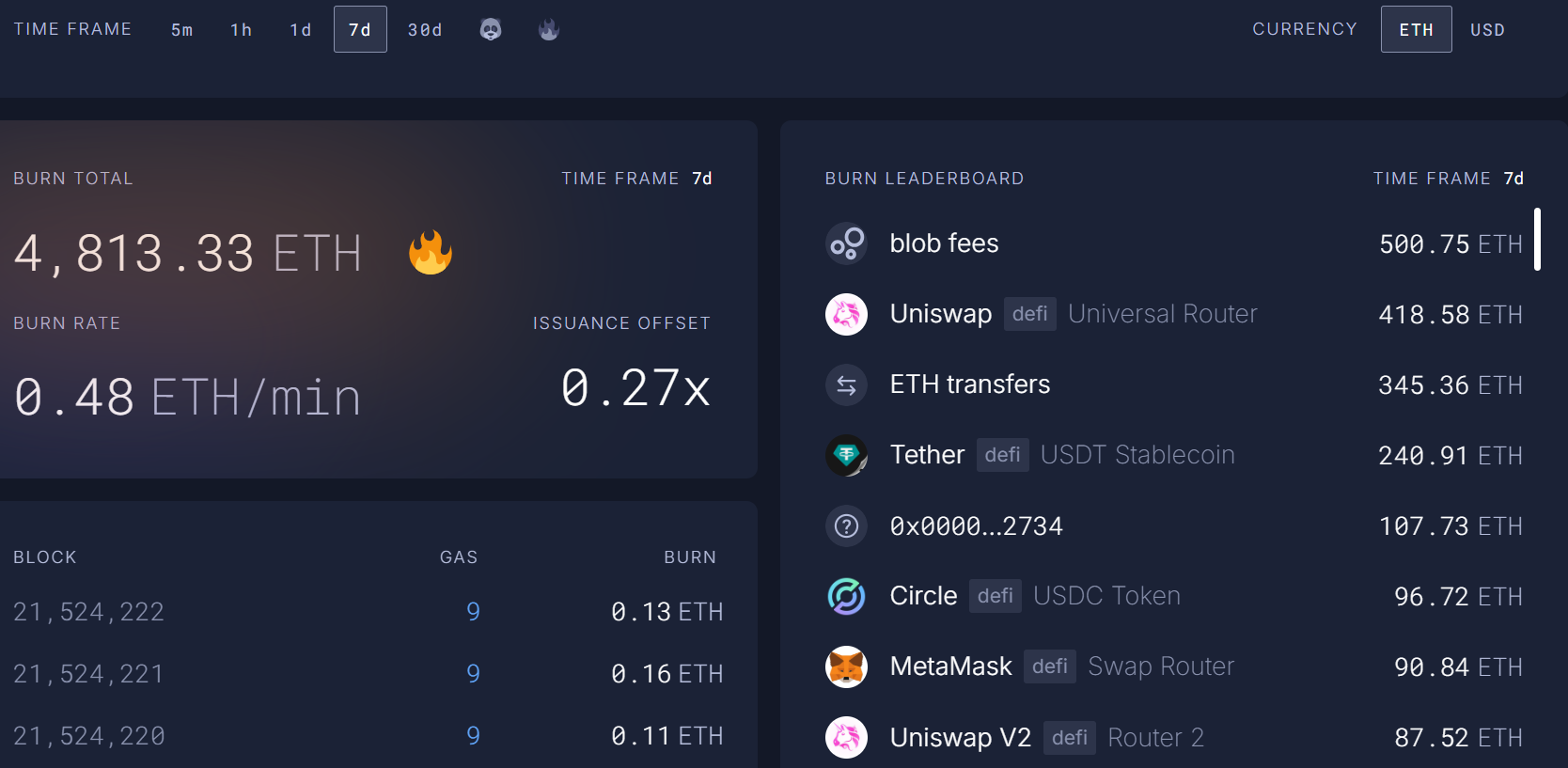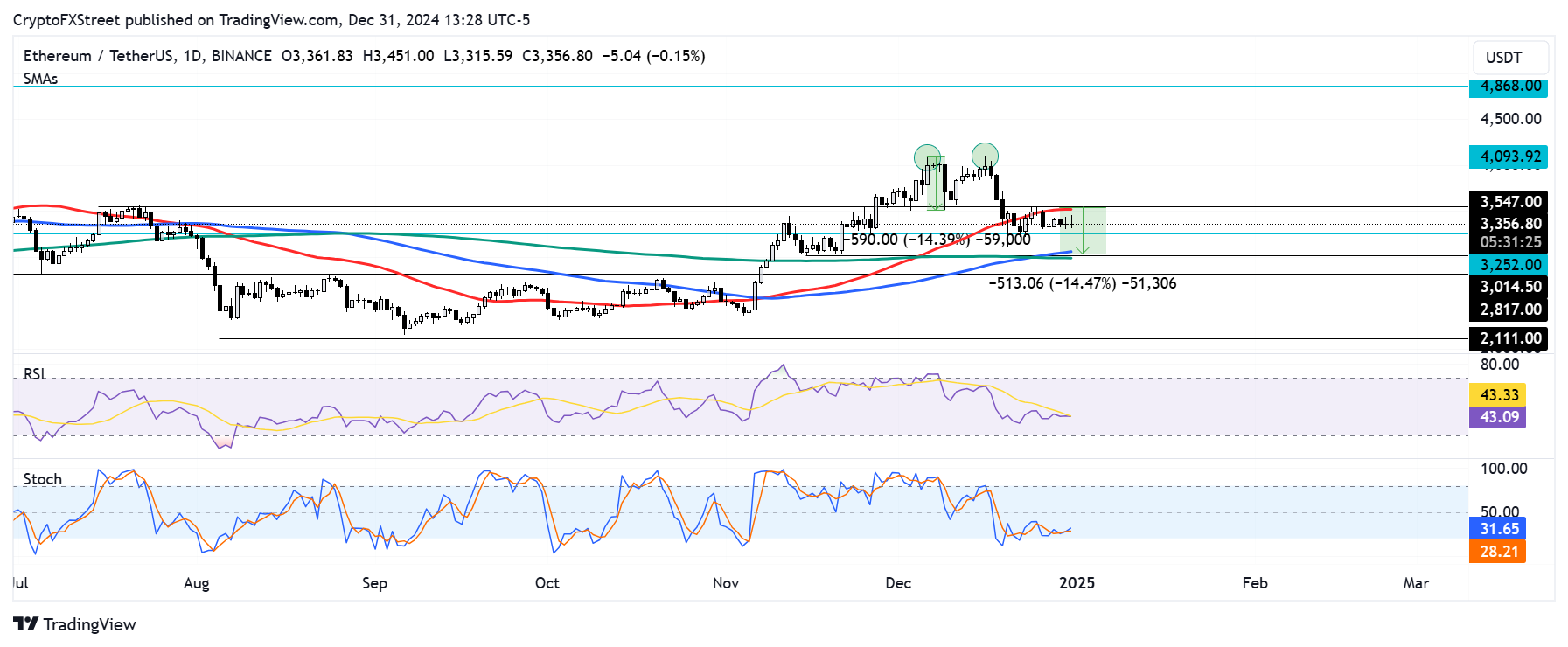Physical Address
304 North Cardinal St.
Dorchester Center, MA 02124
Physical Address
304 North Cardinal St.
Dorchester Center, MA 02124

Ethereum (ETH) fell 1% on Tuesday following a weekly consolidation of the general crypto market. The best altcoin could be set for a bullish 2025 if spots continue their recent trend of spending large amounts of ETH.
The Ethereum burn leaderboard reveals that blob fees have burned over 500 ETH in the past week — the most, above Uniswap and ETH transfers. This emerging trend is somewhat opposite to the trajectory that ETH followed for most of 2024.

ETH Burn Leaderboard. Source: Ultrazvuk.novac
The introduction of blobspace on Ethereum blocks via the Dencun upgrade in March significantly scaled Layer 2 and reduced their transaction fees. However, the fee reduction offset the burning mechanism, which was responsible for maintaining the ETH deflation, with supply increasing by over 400k ETH between April and December.
The ETH burning mechanism was introduced on the August 2021 London hardfork to prevent the supply of ETH from growing by permanently removing some of the transaction fees from circulation.
However, with Layer 2 networks experiencing increased volumes recently, the average number of taints per block often exceeded the target of 3.0, forcing them to enter price discovery. As a result, L2s pay transaction fees for additional usage, increasing the amount of ETH consumed daily.

Ethereum Average number of blobs per block. Source: Dune (@hildobby)
If Ethereum network activity heats up as the holidays draw to a close and taint continues its trend of burning ETH, this could lead to a quick reversal of the negative sentiment around taint and, by extension, ETH. Such a change could reinforce ETH’s “ultrasound money” narrative and increase its appeal to investors.
Meanwhile, Ethereum exchange-traded funds (ETFs) ended their four-day inflow streak after posting net outflows of $55.4 million on Monday, according to data from Coinglass.
Ethereum has suffered more than $31.19 million in liquidations in the last 24 hours, according to data from Coinglass. The total amount of liquidated long positions amounted to $19.37 million, while short liquidations amounted to $11.82 million.
Ethereum has been range-bound over the past 12 days, moving within a price range of $3,250 and $3,550. The consolidation, which reflects the general activity of the crypto market, could be largely due to the lack of trading volume as most traders are on vacation after the Christmas and New Year holidays.

ETH/USDT Daily Chart
If ETH tilts lower and drops below $3,250 when traders return on January 2, it could bounce back from the psychological $3,000 level. Such a move will complete the maximum profit target of the double top pattern, the top altcoin released on December 6th and 16th. Failure to find support at $3,000 could trigger strong selling pressure on ETH.
If ETH leans higher and sustains heavy volume above the $3,550 level, it could retest the major resistance at $4,093. This resistance is a major level to watch as 2025 unfolds. Heavy volume above $4,093 could see ETH tackle its all-time high resistance at $4,868.
The Relative Strength Index (RSI) and Stochastic Oscillator (Stoch) momentum are below their neutral levels, indicating dominant bearish momentum. A cross above their neutral levels will indicate a potential continuation of ETH’s uptrend.
A daily close of the candle below the key support level of $2,817 will invalidate the thesis and could send ETH towards the $2,200 region.
Ethereum is a decentralized open source blockchain with smart contract functionality. Its parent currency Ether (ETH) is the second largest cryptocurrency and the number one altcoin by market capitalization. The Ethereum network is adapted to build crypto solutions such as Decentralized Finance (DeFi), GameFi, Non-Fungible Tokens (NFT), Decentralized Autonomous Organizations (DAO), etc.
Ethereum is a public decentralized blockchain technology, where developers can build and deploy applications that work without the need for a central authority. To facilitate this, the network uses the Solidity programming language and the Ethereum virtual machine to help developers create and run applications with smart contract functionality.
Smart contracts are publicly verifiable codes that automate agreements between two or more parties. Basically, these codes execute coded actions themselves when predetermined conditions are met.
Staking is the process of earning a return on your inactive crypto assets by locking them in a crypto protocol for a certain period of time as a way of contributing to its security. On September 15, 2022, Ethereum switched from a Proof-of-Work (PoW) consensus mechanism to a Proof-of-Stake (PoS) in an event called “The Merger.” The merger was a key part of Ethereum’s plan to achieve high levels of scalability, decentralization and security while remaining sustainable. Unlike PoW, which requires the use of expensive hardware, PoS lowers the barrier to entry for validators by leveraging the use of crypto tokens as the fundamental foundation of its consensus process.
Gas is a unit of measurement for transaction fees that users pay to conduct transactions on Ethereum. During periods of network congestion, gas can be extremely high, causing validators to prioritize transactions based on their fees.